2. 中南大学湘雅三医院检验科, 湖南 长沙 410013;
3. 湖南省细菌耐药监测网办公室, 湖南 长沙 410008;
4. 浏阳市中医医院检验科, 湖南 浏阳 410300;
5. 中南大学湘雅医院检验科, 湖南 长沙 410008;
6. 湘潭市中心医院检验科, 湖南 湘潭 411100;
7. 湖南中医药大学第一附属医院医学检验与病理中心, 湖南 长沙 410007;
8. 长沙市中心医院检验科, 湖南 长沙 410004;
9. 长沙市第一医院检验科, 湖南 长沙 410005;
10. 张家界市人民医院检验科, 湖南 张家界 427000;
11. 郴州市第一人民医院检验医学中心, 湖南 郴州 423000;
12. 湖南省医院感染管理质量控制中心, 湖南 长沙 410008;
13. 国家老年疾病临床医学研究中心(湘雅医院), 湖南 长沙 410008
2. Department of Laboratory Medicine, The Third Xiangya Hospital of Central South University, Changsha 410013, China;
3. Hunan Provincial Antimicrobial Resistance Surveillance System Office, Changsha 410008, China;
4. Department of Laboratory Medicine, Liu-yang Traditional Chinese Medicine Hospital, Liuyang 410300, China;
5. Department of Laboratory Medicine, Xiangya Hospital, Central South University, Changsha 410008, China;
6. Department of Laboratory Medicine, Xiangtan Central Hospital, Xiangtan 411100, China;
7. Medical Laboratory and Pathology Center, The First Hospital of Hunan University of Chinese Medicine, Changsha 410007, China;
8. Department of Laboratory Medicine, Changsha Central Hospital, Changsha 410004, China;
9. Department of Laboratory Medicine, The First Hospital of Changsha, Changsha 410005, China;
10. Department of Laboratory Medicine, Zhangjiajie People's Hospital, Zhangjiajie 427000, China;
11. Center of Laboratory Medicine, The First People's Hospital of Chenzhou, Chenzhou 423000, China;
12. Hunan Provincial Healthcare-associated Infection Management Quality Control Center, Changsha 410008, China;
13. National Clinical Research Center for Geriatric Disorders[Xiangya Hospital], Changsha 410008, China
不动杆菌属(Acinetobacter spp.)是目前导致医院感染的常见细菌之一,且耐药率高[1];鲍曼不动杆菌(Acinetobacter baumannii, AB)是不动杆菌属中最常见的菌种,是医疗环境中广泛存在的条件致病菌之一,且易在高危人群中引发严重的感染。随着碳青霉烯类抗生素在临床上的使用,耐碳青霉烯类鲍曼不动杆菌(carbapenem-resistant Acinetobacter baumannii, CRAB)已在世界范围内出现流行[2-3]。湖南省细菌耐药监测网成立于2011年,依托于湖南省医院感染管理质量控制中心建立[4],覆盖了湖南省所有区县,是该省规模最大的细菌耐药监测网[5]。为了解湖南省AB的流行病学,本研究通过分析该省细菌耐药监测网多中心10年间不动杆菌属的监测数据,旨在为本地区的耐药监测、医院感染防控以及抗菌药物合理使用等方面提供理论依据,现将结果报告如下。
1 资料与方法 1.1 资料来源数据来自2012—2021年湖南省细菌耐药监测网成员单位。监测网成员单位将细菌监测数据从医院信息系统、药敏测定系统直接导入或手工录入WHONET软件,通过湖南省细菌耐药监测网上报,要求上报数据包括细菌药敏的最低抑菌浓度(MIC)值或抑菌圈直径等。经数据审核,剔除质量不合格单位,2012—2021年纳入数据分析的医院分别为162、162、166、164、161、163、163、166、165、162所。
1.2 技术方法不动杆菌的鉴定方法、质控菌株选择及测试抗菌药物种类参照全国细菌耐药监测网(CARSS)技术方案[6]执行。药敏试验结果按照美国临床实验室标准化协会(Clinical & Laboratory Standards Institute, CLSI)推荐的抗微生物药物敏感性试验执行标准2022年版(M100第32版)进行判断[7],结果分为敏感(S)、中介/剂量依赖型敏感(I/SDD)、耐药(R)三种情况,文中I/SDD结果未列出。CRAB定义为AB对亚胺培南(MIC法≥8 μg/mL或纸片法10 mg抑菌圈直径≤18 mm)或美罗培南(MIC法≥8 μg/mL或纸片法10 mg抑菌圈直径≤14 mm)耐药;碳青霉烯类敏感鲍曼不动杆菌(carbapenem-sensitive Acinetobacter baumannii, CSAB) 定义为对亚胺培南(MIC法≤2 μg/mL或纸片法10 mg抑菌圈直径≥22 mm)或美罗培南(MIC法≤2 μg/mL或纸片法10 mg抑菌圈直径≥18 mm) 敏感[7]。多黏菌素B参考欧盟药敏试验标准委员会(European Committee on Antimicrobial Susceptibility Testing, EUCAST)推荐折点[8]。
1.3 资料收集依据每例患者相同标本统计第一株菌的原则,剔除重复菌株。收集监测数据中不动杆菌属种类、株数、药敏结果、是否为重症监护病房(ICU)送检(包括综合ICU、专科ICU、急诊ICU)、标本来源(包括痰/支气管肺泡灌洗液、脓/分泌物、尿、血、引流液、导管、脑脊液等),以及患者性别、年龄等资料。
1.4 统计分析应用WHONET 5.6软件进行药敏结果分析,应用SPSS 27.0统计软件进行数据分析。对于同一种抗菌药物同时有KB法和MIC法结果的,应用Excel软件进行最终S、I和R的计算。计数资料以百分比表示,组间比较采用χ2检验。以P≤0.05为差异有统计学意义。
2 结果 2.1 不动杆菌属的种类湖南省细菌耐药监测网10年间共检出不动杆菌属169 438株,其中居前3位的分别为AB(82.74%)、洛菲不动杆菌(3.99%)、琼氏不动杆菌(2.12%)。见表 1。
| 表 1 2012—2021年湖南省细菌耐药监测网不动杆菌属的细菌种类 Table 1 Species of Acinetobacter spp., Hunan Provincial Antimicrobial Resistance Surveillance System, 2012-2021 |
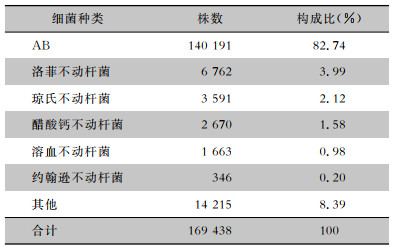
|
湖南省细菌耐药监测网10年间共检出AB 140 191株,其中132 255株进行了碳青霉烯类抗生素药敏检测,检出CRAB 70 923株,10年间CRAB检出率为46.88%~57.64%(平均检出率为53.63%);检出CSAB 58 149株,10年间检出率为32.13%~46.78% (平均检出率为43.97%)。见表 2。
| 表 2 2012—2021年湖南省细菌耐药监测网AB的检出情况 Table 2 Detection of AB, Hunan Provincial Antimicrobial Resistance Surveillance System, 2012-2021 |
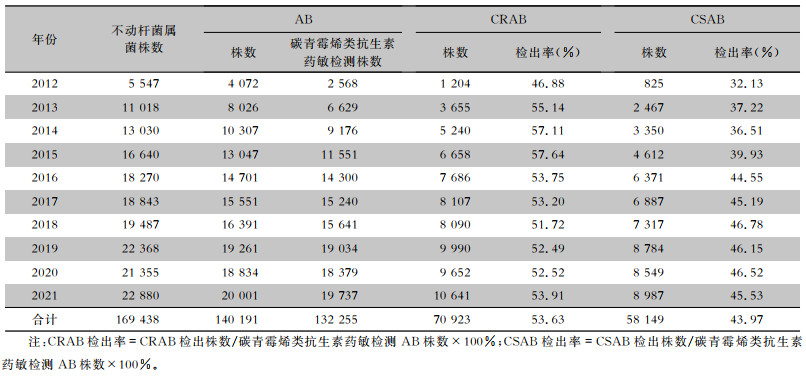
|
CRAB和CSAB均在男性患者中检出居多,分别为69.53%、66.67%;两组患者不同性别检出株数构成比较,差异有统计学意义(P<0.05)。CRAB在<1岁年龄段检出最少(1.08%),>70岁年龄段检出最多(34.44%);而CSAB在11~20岁年龄段检出最少(1.91%),>70岁年龄段检出最多(32.02%);两组年龄构成比较,差异有统计学意义(P<0.05)。CRAB与CSAB在ICU中检出的占比分别为34.80%、11.31%;两组是否在ICU检出构成比较,差异有统计学意义(P<0.001)。见表 3。
| 表 3 CRAB与CSAB检出菌患者来源情况 Table 3 Information of CRAB- and CSAB-positive patients |
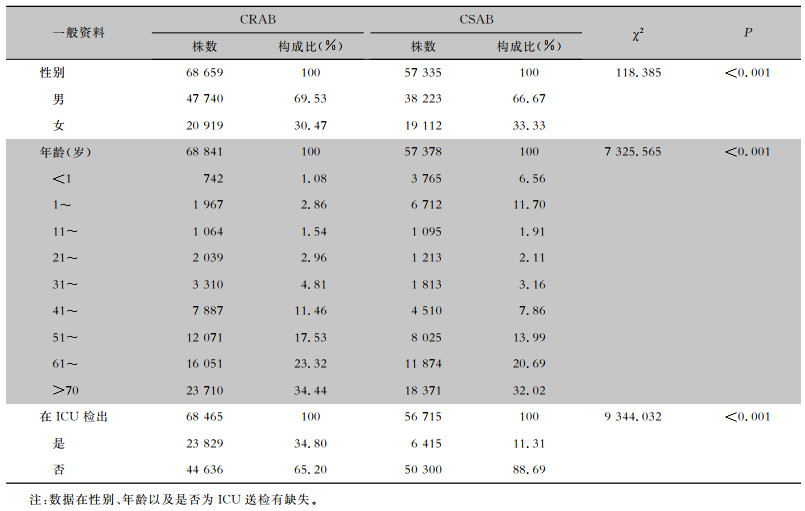
|
CRAB主要分离自痰/支气管肺泡灌洗液(84.18%),其次为脓/分泌物(6.18%)、尿(2.51%)、血(1.96%)、引流液(1.15%)、导管(0.88%)、脑脊液(0.70%),见表 4。CSAB也主要分离自痰/支气管肺泡灌洗液(77.58%),其次为脓/分泌物(7.05%)、尿(6.44%)、血(3.60%)、引流液(0.89%)、导管(0.61%)、脑脊液(0.37%),见表 5。
| 表 4 2012—2021年湖南省细菌耐药监测网CRAB的标本来源情况 Table 4 Specimen sources of CRAB, Hunan Provincial Antimicrobial Resistance Surveillance System, 2012-2021 |
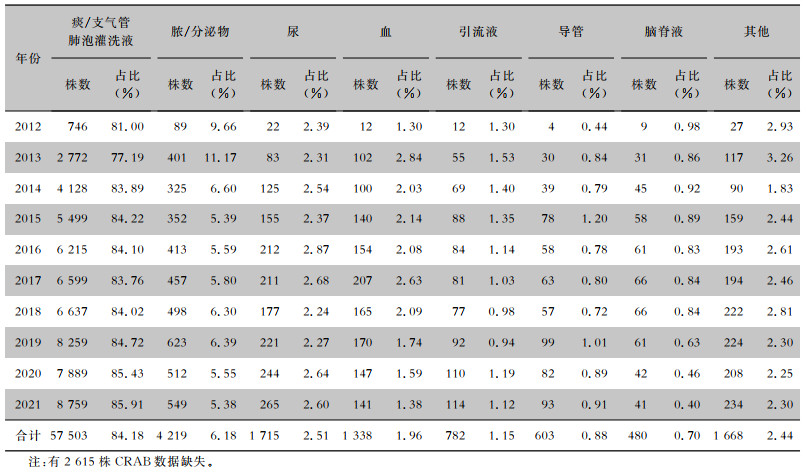
|
| 表 5 2012—2021年湖南省细菌耐药监测网CSAB的标本来源情况 Table 5 Specimen sources of CSAB, Hunan Provincial Antimicrobial Resistance Surveillance System, 2012-2021 |
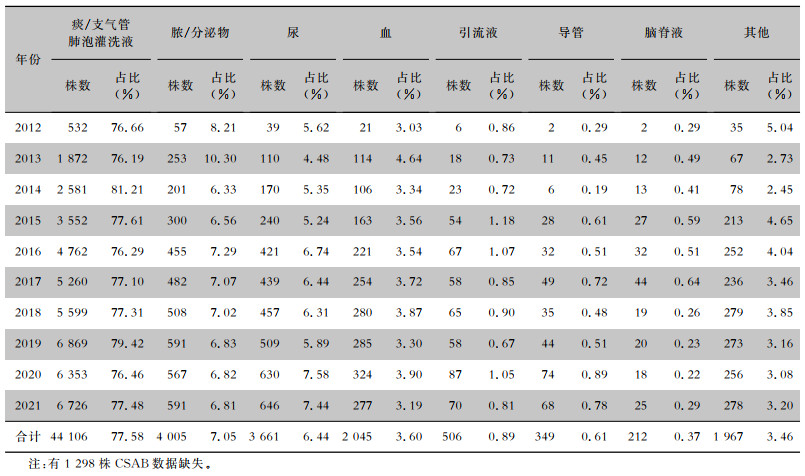
|
CRAB对头孢他啶和头孢吡肟的耐药率高,均>84%;对氨苄西林/舒巴坦、哌拉西林/他唑巴坦的耐药率也较高,均>82%;与庆大霉素、妥布霉素相比,对阿米卡星的耐药率相对较低,为59.3%~78.1%;与环丙沙星相比,对左氧氟沙星的耐药率相对较低,为64.8%~80.6%;对米诺环素、多黏菌素B的耐药率较低,分别维持在15.9%~25.0%、1.3%~6.9%,见表 6。CSAB对常用抗菌药物均较敏感,对氨苄西林/舒巴坦、哌拉西林/他唑巴坦、阿米卡星、庆大霉素、妥布霉素的敏感率均>82%,对左氧氟沙星、环丙沙星的敏感率均>86%,对米诺环素的敏感率>88%,对多黏菌素B的敏感率>92%。见表 7。
| 表 6 2012—2021年湖南省细菌耐药监测网CRAB的药敏试验结果 Table 6 Antimicrobial susceptibility testing results of CRAB, Hunan Provincial Antimicrobial Resistance Surveillance System, 2012-2021 |
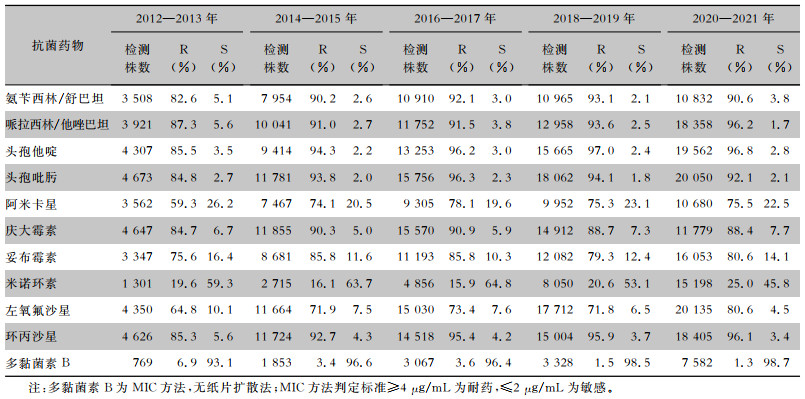
|
| 表 7 2012—2021年湖南省细菌耐药监测网CSAB的药敏试验结果 Table 7 Antimicrobial susceptibility testing results of CSAB, Hunan Provincial Antimicrobial Resistance Surveillance System, 2012-2021 |
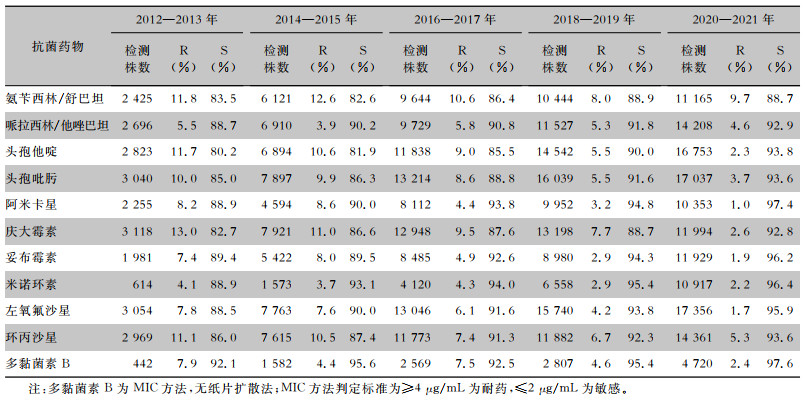
|
CRAB作为二十一世纪最具挑战性公共卫生问题之一,得到了全世界的广泛关注。耐碳青霉烯类不动杆菌已纳入2019年美国疾病预防与控制中心抗菌药物耐药性“紧急威胁”报告中,CRAB也是世界卫生组织2017年发布首份需要新型抗菌药物的“Ⅰ类重点/极为重要”的细菌。全球各个国家对CRAB的分离率在30%~80%,其中亚洲、东欧和拉丁美洲的分离率最高[9-10];根据中国细菌耐药监测网(CHINET) 结果显示2022年全国AB对亚胺培南和美罗培南的耐药率分别高达71.2%、71.9%。本次研究结果显示,2012—2021年湖南省不动杆菌属分离菌株主要以AB为主(占82.74%);AB分离菌株数量出现持续上升,2021年比2011年增加了近5倍;10年间CRAB检出率为46.88%~57.64%,与全国细菌耐药监测网[11]湖南省CRAB的检出率相近,湖南省AB对亚胺培南和美罗培南的耐药率低于全国,但目前AB对碳青霉烯类耐药率最高,依然需要引起重视。
AB为条件致病菌,容易引起老年患者、危重症患者以及免疫力低下的患者发生严重的机会性感染[12]。本次研究显示CRAB与CSAB在>60岁年龄段患者中的检出率高达50%;且CRAB (34.80%)在ICU的检出比率高于CSAB(11.31%),这与ICU患者病情危重,住院时间长,往往需要使用长时间、大剂量广谱高效抗菌药物治疗,增加了碳青霉烯类药物的使用频率相关,导致ICU中CRAB分离率高于非ICU。所以需要对ICU、老年患者更加关注CRAB,包括CRAB定植患者以及感染患者,需要严格落实隔离预防措施,采取有效的接触隔离,避免在ICU中引起CRAB的交叉传播与感染暴发。
AB易在住院患者的呼吸道、皮肤、泌尿道等部位出现定植,当机体免疫力下降时,容易引起呼吸系统、皮肤以及泌尿系统等感染[13]。本次标本来源研究结果显示CRAB和CSAB主要分离自痰/支气管肺泡灌洗液,其次为脓/分泌物、尿。CRAB在痰/支气管肺泡灌洗液的分离率(84.18%)略高于CSAB(77.58%),CSAB在无菌体液(血、脑脊液、导管)中的分离率高于CRAB;一项荟萃分析[14]也显示,引起医院获得性肺炎(HAP)和呼吸机相关肺炎(VAP)的60%~87%AB具有多重耐药性。提示肺部感染以及进行气管插管、使用呼吸机辅助呼吸的患者更容易出现耐药AB。
CRAB具有较强的耐药性,且耐药机制较为复杂,包括碳青霉烯酶的产生、主动外排泵的过度表达、外膜通透性降低、生物膜的形成、抗菌药物靶点改变等[15]。其中碳青霉烯酶是AB对碳青霉烯类抗生素产生耐药最主要的,也是最重要的机制。碳青霉烯酶能够水解β-内酰胺类抗生素,并且不易受舒巴坦、克拉维酸等药物的抑制。本次药敏研究结果显示10年间CRAB对常用抗菌药物的耐药率变化不大。CRAB不仅对碳青霉烯类抗生素产生高耐药性,对头孢类药物以及其他β-内酰胺类含酶抑制剂复合抗生素均呈现比较高的耐药率(均>82%);CRAB对氨基糖苷类、喹诺酮类药物耐药率也较高(均>59%)。目前治疗CRAB相对比较敏感的常用抗菌药物为米诺环素、多黏菌素B,耐药率分别为15.9%~25.0%、1.3%~6.9%。CSAB对常用的抗菌药物往往均较敏感。CRAB的出现导致临床治疗愈发困难,影响患者康复进程。
综上所述,通过对湖南省细菌耐药监测网多中心的不动杆菌属10年的监测数据分析发现,CRAB分离率较高,尤其是在ICU、老年患者以及下呼吸道标本中。10年间CRAB对常用抗菌药物的耐药率变化不大,表现对常用的抗菌药物均有高耐药性。医疗机构应重视CRAB的检出,及时采取有效的干预措施,遏制耐药率的增长,减少其在医疗机构中的传播和交叉感染。
利益冲突:所有作者均声明不存在利益冲突。
| [1] |
Almasaudi SB. Acinetobacter spp. as nosocomial pathogens: epidemiology and resistance features[J]. Saudi J Biol Sci, 2018, 25(3): 586-596. DOI:10.1016/j.sjbs.2016.02.009 |
| [2] |
Tacconelli E, Carrara E, Savoldi A, et al. Discovery, research, and development of new antibiotics: the WHO priority list of antibiotic-resistant bacteria and tuberculosis[J]. Lancet Infect Dis, 2018, 18(3): 318-327. DOI:10.1016/S1473-3099(17)30753-3 |
| [3] |
Perez F, Hujer AM, Hujer KM, et al. Global challenge of multidrug-resistant Acinetobacter baumannii[J]. Antimicrob Agents Chemother, 2007, 51(10): 3471-3484. DOI:10.1128/AAC.01464-06 |
| [4] |
湖南省人民政府. 我省建立医疗机构细菌耐药监测网[EB/OL]. (2011-11-28)[2023-06-20]. http://www.hunan.gov.cn/hnszf/hnyw/zwdt/201212/t20121210_4733059.html. People's Government of Hunan Province. Our province has established a bacterial resistance monitoring network for medical institutions[EB/OL]. (2011-11-28)[2023-06-20]. http://www.hunan.gov.cn/hnszf/hnyw/zwdt/201212/t20121210_4733059.html. |
| [5] |
文细毛, 付陈超, 任南, 等. 湖南省细菌耐药监测网2011年度监测报告[J]. 中国感染控制杂志, 2012, 11(5): 321-327. Wen XM, Fu CC, Ren N, et al. Hunan Provincial Bacterial Antimicrobial-Resistance Surveillance System: 2011 survei-llance report[J]. Chinese Journal of Infection Control, 2012, 11(5): 321-327. |
| [6] |
全国细菌耐药监测网. 《全国细菌耐药监测网技术方案(2022年版)》修订说明[EB/OL]. (2022-04-06)[2023-06-20]. http://carss.cn/Notice/Details/823. China Antimicrobial Resistance Surveillance System. Revision Explanation of the technical plan for China Antimicrobial Resistance Surveillance System (2022 edition)[EB/OL]. (2022-04-06)[2023-06-20]. http://carss.cn/Notice/Details/823. |
| [7] |
CLSI. M100: performance standards for antimicrobial susceptibility testing, 32nd edition[EB/OL]. [2023-06-20]. https://www.standards-global.com/wp-content/uploads/pdfs/preview/2247002.
|
| [8] |
Satlin MJ, Lewis JS II, Weinstein MP, et al. Clinical and Laboratory Standards Institute and European Committee on Antimicrobial Susceptibility Testing position statements on polymyxin B and colistin clinical breakpoints[J]. Clin Infect Dis, 2020, 71(9): e523-e529. |
| [9] |
Huang ST, Chiang MC, Kuo SC, et al. Risk factors and clinical outcomes of patients with carbapenem-resistant Acinetobacter baumannii bacteremia[J]. J Microbiol Immunol Infect, 2012, 45(5): 356-362. DOI:10.1016/j.jmii.2011.12.009 |
| [10] |
Bardbari AM, Arabestani MR, Karami M, et al. Correlation between ability of biofilm formation with their responsible genes and MDR patterns in clinical and environmental Acinetobacter baumannii isolates[J]. Microb Pathog, 2017, 108: 122-128. DOI:10.1016/j.micpath.2017.04.039 |
| [11] |
全国细菌耐药监测网. 全国细菌耐药监测网2014-2019年临床分离非发酵革兰阴性杆菌耐药性变迁[J]. 中国感染控制杂志, 2021, 20(1): 69-75. China Antimicrobial Resistance Surveillance System. Change in antimicrobial resistance of clinically isolated non-fermentative Gram-negative bacilli: surveillance report from China Antimicrobial Resistance Surveillance System in 2014-2019[J]. Chinese Journal of Infection Control, 2021, 20(1): 69-75. |
| [12] |
Liu CC, Chen KC, Wu YC, et al. Epidemiological and genetic characteristics of clinical carbapenem-resistant Acinetobacter baumannii strains collected countrywide from hospital intensive care units (ICUs) in China[J]. Emerg Microbes Infect, 2022, 11(1): 1730-1741. DOI:10.1080/22221751.2022.2093134 |
| [13] |
Whiteway C, Breine A, Philippe C, et al. Acinetobacter baumannii[J]. Trends Microbiol, 2022, 30(2): 199-200. |
| [14] |
Mohd Sazlly Lim S, Zainal Abidin A, Liew SM, et al. The global prevalence of multidrug-resistance among Acinetobacter baumannii causing hospital-acquired and ventilator-associated pneumonia and its associated mortality: a systematic review and Meta-analysis[J]. J Infect, 2019, 79(6): 593-600. |
| [15] |
唐娜, 唐子毅, 姚磊. 耐碳青霉烯鲍曼不动杆菌抗菌药物的耐药机制研究[J]. 中国处方药, 2023, 21(4): 181-184. Tang N, Tang ZY, Yao L. A study on the resistance mechanism of carbapenem resistant Acinetobacter baumannii to antibiotics[J]. Journal Of China Prescription Drug, 2023, 21(4): 181-184. |



